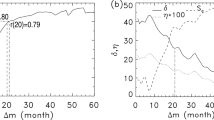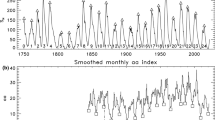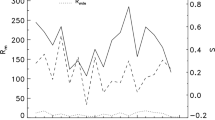Abstract
Yoshida and Yamagishi (Ann. Geophys. 28, 417, 2010) found that the rate of decrease in the smoothed monthly mean sunspot number [\(R_{\mathrm{I}}\)] over the final three years of a solar cycle or \(R_{\mathrm{I}}\) itself at three years before the solar minimum [\(R_{ \mathrm{min}}\)] can be used as a precursor for the ensuing maximum amplitude [\(R_{\mathrm{m}}\)] if the time of \(R_{\mathrm{min}}\) can be predicted in advance. The \(R_{\mathrm{I}}\) series of the new version is employed to carefully analyze the decrease rate [\(\beta \)] at different months [\(m\)] before \(R_{\mathrm{min}}\) and over different time intervals [\(\Delta m\)] in this study. It is found that \(R_{\mathrm{m}}(n)\) of Solar Cycle \(n\) is best correlated (\(r=0.831\)) with the preceding \(\beta (n-1, m, \Delta m)\) over the final \(\Delta m=m=39\) months. In addition, \(R_{\mathrm{m}}\) is found to be best correlated (\(r=0.834\)) with the \(R_{\mathrm{I}}\) value 39 months before the preceding minimum. For the even- (odd-)numbered cycles, \(R_{\mathrm{m}}\) is best correlated, \(r=0.956\) (0.747), with the rate of decrease over \(\Delta m= 38 (43)\) months interval from \(m=39(47)\) months before the solar minimum, and \(R_{\mathrm{m}}\) is best correlated, \(r=0.964(0.739)\), with the \(R_{\mathrm{I}}\)-value 39 (46) months before the solar minimum. Based on this method and the inferred end time of Solar Cycle 24, the amplitude of Solar Cycle 25 is predicted to be \(R_{\mathrm{m}}=130.0\pm 31.9\), occurring around October 2024 \(\pm 13\) (months).







Similar content being viewed by others
References
Babcock, H.W.: 1961, The topology of the Sun’s magnetic field and the 22-year cycle. Astrophys. J. 133, 572. DOI.
Brown, G.M., Williams, W.R.: 1969, Some properties of the day-to-day variability of Sq(H). Planet. Space Sci. 17, 455. DOI.
Cameron, R., Schüssler, M.: 2007, Solar cycle prediction using precursors and flux transport models. Astrophys. J. 659, 801. DOI.
Cameron, R., Schüssler, M.: 2008, A robust correlation between growth rate and amplitude of solar cycles: Consequences for prediction methods. Astrophys. J. 685, 1291. DOI.
Choudhuri, A.R., Chatterjee, P., Jiang, J.: 2007, Predicting Solar Cycle 24 with a solar dynamo model. Phys. Rev. Lett. 98, 131103. DOI.
Clette, F., Cliver, E., Lefèvre, L., Svalgaard, L., Vaquero, J., Leibacher, J.: 2016, Preface to topical issue: Recalibration of the sunspot number. Solar Phys. 291, 2479. DOI.
Dikpati, M., de Toma, G., Gilman, P.A.: 2006, Predicting the strength of Solar Cycle 24 using a flux-transport dynamo-based tool. Geophys. Res. Lett. 33, L05102. DOI.
Du, Z.L.: 2011a, The relationship between prediction accuracy and correlation coefficient. Solar Phys. 270, 407. DOI.
Du, Z.L.: 2011b, The shape of solar cycle described by a modified Gaussian function. Solar Phys. 273, 231. DOI.
Du, Z.L.: 2020, Predicting the shape of Solar Cycle 25 using a similar-cycle method. Solar Phys. 295, 134. DOI.
Du, Z.L., Wang, H.N.: 2010, Does a low solar cycle minimum hint at a weak upcoming cycle? Res. Astron. Astrophys. 10, 950. DOI.
Du, Z.L., Wang, H.N.: 2011, The prediction method of similar cycles. Res. Astron. Astrophys. 11, 1482. DOI.
Du, Z.L., Wang, H.N.: 2012, Predicting the solar maximum with the rising rate. Sci. China Ser. G, Phys. Mech. Astron. 55, 365. DOI.
Du, Z.L., Li, R., Wang, H.N.: 2009, The predictive power of Ohl’s precursor method. Astron. J. 138, 1998. DOI.
Du, Z.L., Wang, H.N., Zhang, L.Y.: 2008, A running average method for predicting the size and length of a solar cycle. Chin. J. Astron. Astrophys. 8, 477. DOI.
Gnevyshev, M.N., Ohl, A.I.: 1948, On the 22-year cycle of solar activity. Astron. Zh. 25, 18.
Hale, G.E.: 1924, Sun-spots as magnets and the periodic reversal of their polarity. Nature 113, 105. DOI.
Han, Y.B., Yin, Z.Q.: 2019, A decline phase modeling for the prediction of Solar Cycle 25. Solar Phys. 294, 107. DOI.
Hathaway, D.H., Wilson, R.M., Reichmann, E.J.: 1994, The shape of the sunspot cycle. Solar Phys. 151, 177. DOI.
Hathaway, D.H., Wilson, R.M., Reichmann, E.J.: 2002, Group sunspot numbers: Sunspot cycle characteristics. Solar Phys. 211, 357. DOI.
Kane, R.P.: 2007, A preliminary estimate of the size of the coming Solar Cycle 24, based on Ohl’s precursor method. Solar Phys. 243, 205. DOI.
Leighton, R.B.: 1969, A magneto-kinematic model of the solar cycle. Astrophys. J. 156, 1. DOI.
Moradi, H., Baldner, C., Birch, A.C., Braun, D.C., Cameron, R.H., Duvall, T.L., Gizon, L., Haber, D., Hanasoge, S.M., Hindman, B.W., Jackiewicz, J., Khomenko, E., Komm, R., Rajaguru, P., Rempel, M., Roth, M., Schlichenmaier, R., Schunker, H., Spruit, H.C., Strassmeier, K.G., Thompson, M.J., Zharkov, S.: 2010, Modeling the subsurface structure of sunspots. Solar Phys. 267, 1. DOI.
Nordemann, D.J.R., Trivedi, N.B.: 1992, Sunspot number time series - exponential fitting and periodicites. Solar Phys. 142, 411. DOI.
Ohl, A.I., Ohl, G.I.: 1979, A new method of very long-term prediction of solar activity. In: Donnelly, R.F. (ed.) NASA Marshall Space Flight Center Solar-Terr. Pred. Proc. 2, 258. ADS.
Pesnell, W.D., Schatten, K.H.: 2018, An early prediction of the amplitude of Solar Cycle 25. Solar Phys. 293, 112. DOI.
Schatten, K.H.: 2005, Fair space weather for Solar Cycle 24. Geophys. Res. Lett. 32, L21106. DOI.
Schatten, K., Myers, D.J., Sofia, S.: 1996, Solar activity forecast for Solar Cycle 23. Geophys. Res. Lett. 23, 605. DOI.
Schatten, K.H., Scherrer, P.H., Svalgaard, L., Wilcox, J.M.: 1978, Using dynamo theory to predict the sunspot number during Solar Cycle 21. Geophys. Res. Lett. 5, 411. DOI.
Schwabe, H.: 1843, Die Sonne. Astron. Nachr. 20, 283. DOI.
Singh, P.R., Tiwari, C.M., Saxena, A.K., Agrawal, S.L.: 2019, Quasi-biennial periodicities and heliospheric modulation of geomagnetic activity during solar cycles 22. Phys. Scr. 94, 105005. DOI.
Stewart, J.Q., Panofsky, H.A.A.: 1938, The mathematical characteristics of sunspot variations. Astrophys. J. 88, 385. DOI.
Svalgaard, L., Cliver, E.W., Kamide, Y.: 2005, Sunspot cycle 24: Smallest cycle in 100 years? Geophys. Res. Lett. 32, L01104. DOI.
Temmer, M., Veronig, A., Hanslmeier, A.: 2003, Does solar flare activity lag behind sunspot activity? Solar Phys. 215, 111. DOI.
Thompson, R.J.: 1988, The rise of solar cycle number 22. Solar Phys. 117, 279. DOI.
Thompson, R.J.: 1993, A technique for predicting the amplitude of the solar cycle. Solar Phys. 148, 383. DOI.
Upton, L.A., Hathaway, D.H.: 2018, An updated Solar Cycle 25 prediction with AFT: The modern minimum. Geophys. Res. Lett. 45, 8091. DOI.
Vondrak, J.: 1977, Problem of smoothing observational data II. Bull. Astron. Inst. Czechoslov. 28, 84. ADS.
Waldmeier, M.: 1939, Über die Struktur der Sonnenflecken. Astron. Mitt. Zür. 14, 439. ADS.
Wilson, R.M.: 1990, On the maximum rate of change in sunspot number growth and the size of the sunspot cycle. Solar Phys. 127, 199. DOI.
Xu, T., Wu, J., Wu, Z.-S., Li, Q.: 2008, Long-term sunspot number prediction based on EMD analysis and AR model. Chin. J. Astron. Astrophys. 8, 337. DOI.
Yin, Z.Q., Han, Y.B.: 2018, An improved prediction of sunspot maximum by Vondrak smoothing method. Astron. Nachr. 339, 30. DOI.
Yoshida, A.: 2014, Difference between even- and odd-numbered cycles in the predictability of solar activity and prediction of the amplitude of cycle 25. Ann. Geophys. 32, 1035. DOI.
Yoshida, A., Sayre, R.: 2012, Tendency of discreteness of the solar amplitude and intercycle relatedness. Adv. Astron. 2012, 519852. DOI.
Yoshida, A., Yamagishi, H.: 2010, Predicting amplitude of Solar Cycle 24 based on a new precursor method. Ann. Geophys. 28, 417. DOI.
Yule, G.U.: 1927, On a method of investigating periodicities in disturbed series, with special reference to Wolfer’s sunspot numbers. Phil. Trans. Roy. Soc. London 226, 267. DOI.
Acknowledgments
We are grateful to the anonymous reviewer for valuable suggestions to improve this manuscript. This work is supported by the National Science Foundation of China (NSFC) through grants 11603040 and 11973058.
Author information
Authors and Affiliations
Corresponding author
Ethics declarations
Disclosure of Potential Conflicts of Interest
The authors declare that they have no conflicts of interest.
Additional information
Publisher’s Note
Springer Nature remains neutral with regard to jurisdictional claims in published maps and institutional affiliations.
Rights and permissions
About this article
Cite this article
Du, Z. Predicting the Amplitude of Solar Cycle 25 Using the Value 39 Months Before the Solar Minimum. Sol Phys 295, 147 (2020). https://doi.org/10.1007/s11207-020-01720-1
Received:
Accepted:
Published:
DOI: https://doi.org/10.1007/s11207-020-01720-1




